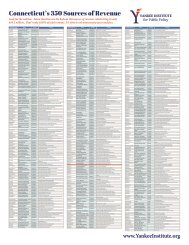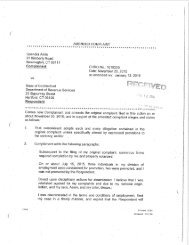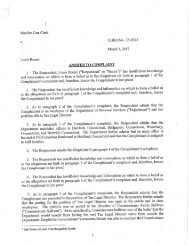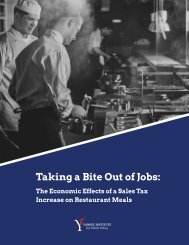Connecticut's Top Ten Business-Friendly Towns
Find out which Connecticut towns are truly open for business!
Find out which Connecticut towns are truly open for business!
You also want an ePaper? Increase the reach of your titles
YUMPU automatically turns print PDFs into web optimized ePapers that Google loves.
The business community, having dealt with the collapse of private-sector pensions over the past 40 years, is<br />
aware that these large unfunded liabilities represent a mortgage on the future of the states and municipalities that<br />
owe them; this goes a long way toward explaining Connecticut’s feeble growth rate in recent years.<br />
In our index, total taxes and future pension obligations per household receive one-third weight in our tax burden<br />
assessment. Millage rates and the total bonded and unfunded liabilities, as determined by Joffe (2017), also each<br />
contribute one-third weight.<br />
Transportation Infrastructure 10%<br />
Connecticut’s transportation infrastructure has fallen into disrepair, despite high gas taxes.4 For the business<br />
community, the mismanagement of transportation funds creates serious problems: Commerce is largely<br />
dependent on businesses’ ability to acquire parts or services from elsewhere, and consumers’ ability to access<br />
goods and services. Without strong transportation infrastructure, the transactions that make commerce possible<br />
are more expensive and potentially prohibitive.<br />
Our research team selected three primary forms of transportation infrastructure: ports of entry, interstate<br />
highways and rail lines. We considered the distance from the center of a municipality to the nearest of each<br />
available mode of transportation, using a variety of indexes and taking averages where minor discrepancies<br />
arose.<br />
Highways like I-95 and I-84 are weighted at 50 percent of the infrastructure category, as they are the main way in<br />
which consumers, commuters and many pre-retail products and services move around the state. The rail system<br />
in Connecticut is not as extensive as it is in other states, but it is used intensively, particularly between Stamford<br />
and Grand Central Station in New York City. For this reason, distance to the nearest rail line is weighted at 30<br />
percent. Lastly, distance to the nearest port of entry, as defined by the U.S. Customs and Border Protection,<br />
attempts to measure a business’ ease of access to larger shipments, often for pre-retail goods like heavy<br />
machinery or raw materials, and is weighted at 20 percent of this category.<br />
<strong>Business</strong>-friendliness index<br />
The four component categories are combined to create an overall business-friendliness index.<br />
The tax burden, community allure and economic vitality categories are weighted at 35 percent each with tax<br />
burden at 20 percent and the transportation infrastructure category making up the final 10 percent. This<br />
weighting reflects both the needs of the current Connecticut economy, which is heavily dependent on the<br />
financial services sector, and the future economy, which will add information technology and 21st century<br />
manufacturing sectors.<br />
4 http://www.connecticutmag.com/the-connecticut-story/connecticut-roads-among-the-nation-s-worstbut-who-pays/article_f20704b0-39c5-11e7-beef-fb00b1bc6ced.html







